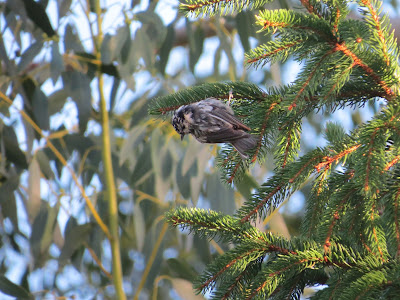A cloudy, mild morning. Dave arrived before I did, and we were keen to get to grips with the Redpoll flock, if it was still there. We drove down the track and soon established that at least 100 were still feeding in the crop field. Unfortunately they departed to the north soon afterwards, and we eventually got bored waiting for them to return.
We opted for a circuit of the patch, meeting Jan and her mutt halfway round. The pool field contained 12 Pied Wagtails and four Meadow Pipits, but no waterfowl. However, the nearest Flash hosted 63 Teal, two Green Sandpipers, and 76 Mallard. A flock of about 20 small finches flew silently by, and we suspected they were Siskins.
The remainder of the circuit past without incident so we drove back down the track, and soon found the Redpolls again. They were at the far side of the field and we wasted too much time scoping them from my car, Dave having not brought a tripod.
Eventually we decided to head across the field, and we were surprised to find that the Redpolls were not unduly troubled by our presence.
We on the other hand were greatly troubled by identification issues. Initially, we could see only Lessers, although we each had brief views of "interesting" birds. Eventually they landed in a nearby bush, and while I scoped a noticeably paler bird, Dave drew my attention to another which was showing a pale rump.
I switched to the bridge camera and attempted some shots. Unfortunately my auto-focus was confused about what I was trying to do, and the result was this blurry image.
 |
| Mealy Redpoll ? |
The rump looked pale enough to me, and I was convinced it was a Mealy Redpoll. Dave, however is always cautious, and he wouldn't commit himself.
I also took a photo of the other pale bird.
To me, this also looked like one (although I didn't see its rump).
We watched as the flock swirled above the crop, both straining to see evidence of a pale rump on the birds in flight. Dave thought he saw something once, but on the whole they looked unremarkable. Things then got gloomier and tenser as I had a great view of a pale-rumped bird in a small tree. I showed Dave the bird expecting the issue to be resolved, but no, Dave was still not happy. Frustratingly, my attempts to photograph this bird were thwarted as I struggled to work out which part of the tree it was in.
Dave and I have been birding mates for nearly thirty years, we almost never disagree on an identification, and as we respect each other's opinion it was stressful to find we couldn't reach agreement on these pesky birds.
We could at least agree that there were a lot of Redpolls, Dave counted 115 in the flock we were studying, and later I counted up the Redpolls on the wires from a photograph, and got a figure 137.
On the walk back to the car we saw a female Stonechat, definitely!
Post Script: I've since heard from Mike who went down on Monday and saw two Mealy Redpolls including one with a white rump that showed well on a flying bird, something Dave and I struggled with.






















